|
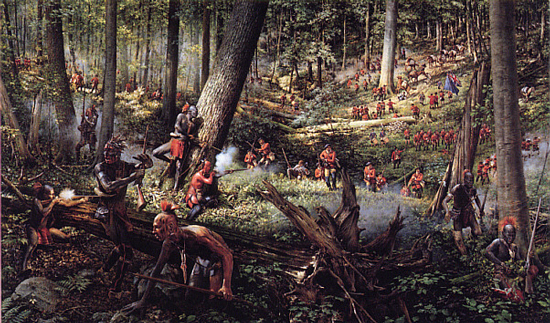
Battle of Bushy Run: August 5-6, 1763
The
defeat at Bushy Run was the
beginning of the end for Pontiac's
Rebellion.
One
Mile to Bushy Run Station by
Robert Griffing
Timeline of Pontiac's
Rebellion 1763-1766
Included are
events that took place before Pontiac's
Rebellion and might be of interest in this
context.
Go here for
 Pontiac's Rebellion in a
Nutshell
Pontiac's Rebellion in a
Nutshell
Go here for more
about
 Pontiac
Pontiac
If
this timeline is too detailed,
check the
 Key
Events of the Pontiac Rebellion,
which are a summary of the years
1763-1766. Key
Events of the Pontiac Rebellion,
which are a summary of the years
1763-1766.
Events Prior to Pontiac's Rebellion
1534
The French
colony
 New France (Nouvelle-France, or
Gallia
Nova) is established.
New France (Nouvelle-France, or
Gallia
Nova) is established.
1535
 Jacques
Cartier winters in the Huron Indian village of Stadacona (today's Quebec).
Jacques
Cartier winters in the Huron Indian village of Stadacona (today's Quebec).
1629
Quebec is
captured by the British
1632
Quebec is
restored to France by the
Treaty of Saint-Germain-en-Laye.
July 24, 1701
The fur-trading post Detroit, aka
Fort Pontchartrain du Detroit,
is established by
Antoine Laumet de La
Mothe Cadillac on the peninsula
between the Detroit River and Savoyard Creek.
The British will rename it later simply Fort
Detroit.
Go here for a map of
 Fort Detroit in 1759
Fort Detroit in 1759
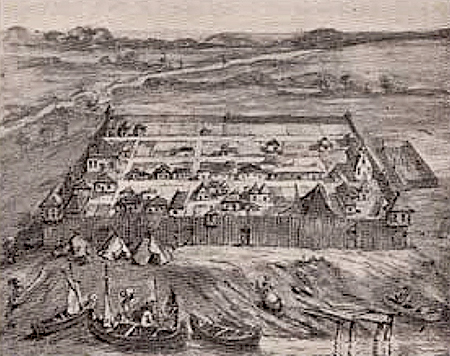
Fort Pontchartrain du Détroit 1701
Burton
Historical Collection
June 19 – July 11, 1754
Albany
Congress - The British negotiate with the
Iroquois.
 Sir William Johnson tries to assure
British support against the French.
Sir William Johnson tries to assure
British support against the French.
1755
Johnson is
appointed superintendent of the Iroquois
Confederacy and its allies.
1756
George Croghan (died in 1782) is appointed deputy to
Sir William Johnson, the newly
created superintendent of Indian affairs for the western nations.
1758
William Pitt
the elder selected
Jeffrey
Amherst over the heads of numerous senior
officers to fight the French. Amherst arrives in
America. He will soon become the
commander-in-chief of His Majesty's Forces in
North America.
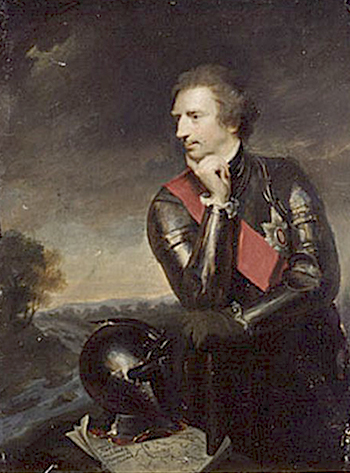
Sir Jeffrey Amherst (1717-1797)
After the
portrait by Sir Joshua Reynolds, 1765
Library and
Archives Canada
April 30, 1759
General James Wolfe arrives from Spithead at
Halifax.
September 13, 1759
 Battle of Quebec, which takes place on the
Plains of Abraham, located adjacent to the city.
British Maj. Gen. Wolfe defeats French Marquis
de Montcalm, who is mortally wounded.
Battle of Quebec, which takes place on the
Plains of Abraham, located adjacent to the city.
British Maj. Gen. Wolfe defeats French Marquis
de Montcalm, who is mortally wounded.
September 18, 1759
French Quebec surrenders to the British. This
will lead to the fall of Canada to Britain.
Early Summer 1760
 Henry Gladwin is detached to assist
Colonel
Henry Bouquet in building Fort Presque Isle
(today's Erie, Pennsylvania).
Henry Gladwin is detached to assist
Colonel
Henry Bouquet in building Fort Presque Isle
(today's Erie, Pennsylvania).
September 8, 1760
At Montreal,
the last governor-general of New France, the
Marquis de Vaudreuil, surrenders his
territory to
Jeffrey Amherst. This transfer will become
official with the 1763 Treaty of Paris.
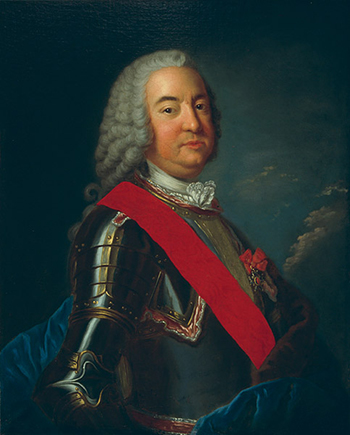
Pierre de Rigaud de Vaudreuil de Cavagnial,
marquis de Vaudreuil
Pierre lived 1698-1778. He was governor of
Louisiana 1743-1755,
and governor-general of Canada 1755-1760
Canadian
Museum of History
Late October 1760
 Henry Gladwin is in command of Fort William
Augustus (formerly Fort Lévis, east of Prescott,
Ontario).
Henry Gladwin is in command of Fort William
Augustus (formerly Fort Lévis, east of Prescott,
Ontario).
November 27, 1760
French
Captain Francois Marie Picot de Belestre
surrenders Fort Pontchartrain de Detroit to British
Major Robert Rogers
and his 200 rangers,
who take over at Detroit and other western posts that the French
cede to the British.
On his way to Michilimackinac, Rogers meets Pontiac
and a group of Ottawa, Huron, and Potawatomi
Indians, who welcome the newcomers with a
sincerely peaceful attitude, expecting the
establishment of new commercial relations and to
be treated respectfully.
End of December
1760
Rogers departs and
Captain Donald
Campbell becomes the British commander of
Fort Detroit. Campbell
is a man who will be described as fat and
unwieldy and suffering from poor eyesight. However, he speaks
French, is relaxed, alert, competent, and most
importantly able to win the trust of Pontiac,
who was previously fighting for the French
against the British.
June 1761
Campbell reports that the new British treatment
of the natives does not go down well at all.
Apparently, the Indians incited "all the Nations from
Nova Scotia to the Illinois to take the hatchet
against the English."
September 1761
Gladwin comes to Detroit,
joining Johnson with a strong contingent of
troops.
Johnson calls a great peace conference
with the natives at
Detroit. At the meeting, Johnson, with a letter from Amherst in his
pocket forbidding him to continue to buy the
Indians' good conduct with presents, offers the
Indians presents.
Wrote Amherst to Johnson,
As to purchasing the good behavior, either
of Indians, or any others, that is what I do
not understand. When men of whatsoever race
behave ill they must be punished but not
bribed.
Although Johnson didn't say a word about Amherst's
planned change
of tradition, the Indians will soon find out when
his orders are implemented.
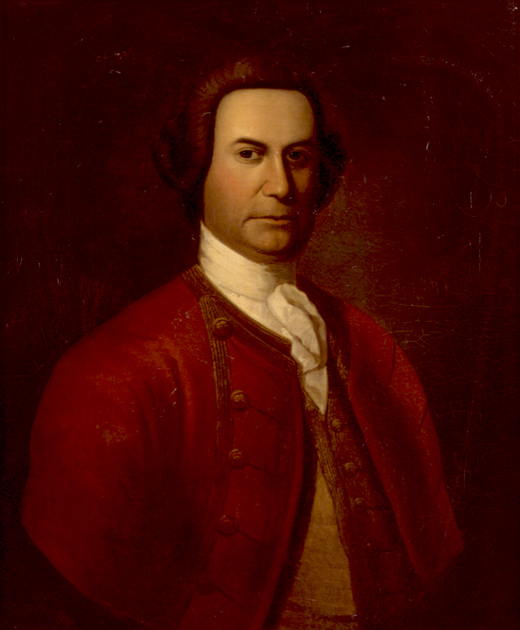
Sir William Johnson,
1st Baronet (1715-1774)
Arriving in America about 1738,
Irish-born Johnson settled in the Mohawk Valley.
A skilled trader
and negotiator, he was appointed Northern Indian Superintendent in
1756. Johnson was a shrewd land speculator, owner of a fortune and a
home which he humbly called Fort Johnson. In 1763, he built Johnson
Hall, his mansion Georgian style, north of Johnstown, NY.
Among other children, Johnson fathered
eight little rascals with Molly Brant, the sister of Mohawk chief
Joseph Brant.
Unlike commander in chief Jeffrey
Amherst, Johnson distributed gifts generously, and he was not above
donning war paint. Consequently, Johnson created a loyal Iroquois following. He is
credited with convincing the Iroquois to stay away from Pontiac's Rebellion.
Johnson is described as "hard-headed
and frequently self-serving, particularly regarding land claims."
This portrait is Edward L. Mooney's
oil on canvas from 1838, after the lost original by Thomas McIlworth
from 1763, which was made to hang in Johnson Hall.
New York Historical Society
Summer of 1762
A
secret council of Ottawa, Ojibwa, Huron,
Potawatomi, and others meets at Detroit. This
meeting has probably been called by Pontiac.
August 23, 1762
Campbell surrenders his command of Fort Detroit
willingly and gladly to
 Major Henry Gladwin.
Campbell remains as second in command.
Major Henry Gladwin.
Campbell remains as second in command.
Also
1762
The Weas in the west and, separately, the Senecas in
the east, try to stir up a rebellion, but the
movement does not get enough traction to amount
to a revolt.
February 10, 1763
The
 Treaty
of Paris is signed and officially ends the war between Britain
and France in North America. France cedes to
Britain all the mainland of North America east
of the Mississippi, excluding New Orleans and
its surroundings.
Treaty
of Paris is signed and officially ends the war between Britain
and France in North America. France cedes to
Britain all the mainland of North America east
of the Mississippi, excluding New Orleans and
its surroundings.
New France has
become British.
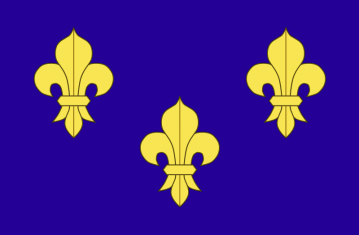
Flag of New
France 1534-1763
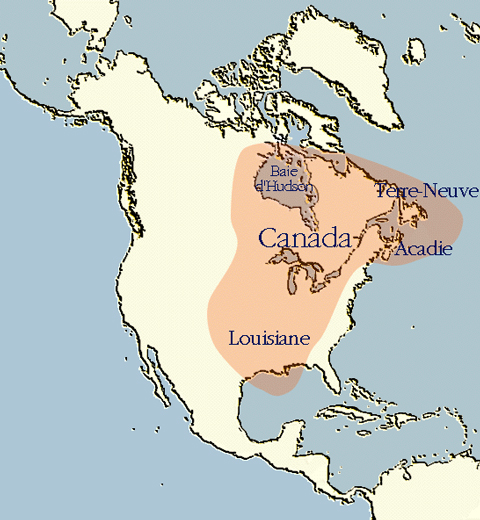
Map of New France early 18th Century
Illustrating Canada, Louisiana, Hudson Bay,
Newfoundland (Terre Neuve), Acadia (Acadie)
Ministere
de la Culture, France
The
challenge for the British is now to win the
allegiance of the Indian tribes who had been
formerly loyal allies of the French.
March 1763
The
Miami receive a war belt from the Senecas, who
still try to instigate an uprising against the
English. But still without being able to
accumulate the required momentum for a revolt.
Timeline of the Pontiac
War (April 27, 1763
- July 25, 1766)
April 27, 1763
(or the Fifteenth of the Moon according to
the Indian calendar)
The intertribal War
Council, also called the
Pontiac Council,
meets along the Ecorse River, ten miles south of
Fort Detroit.
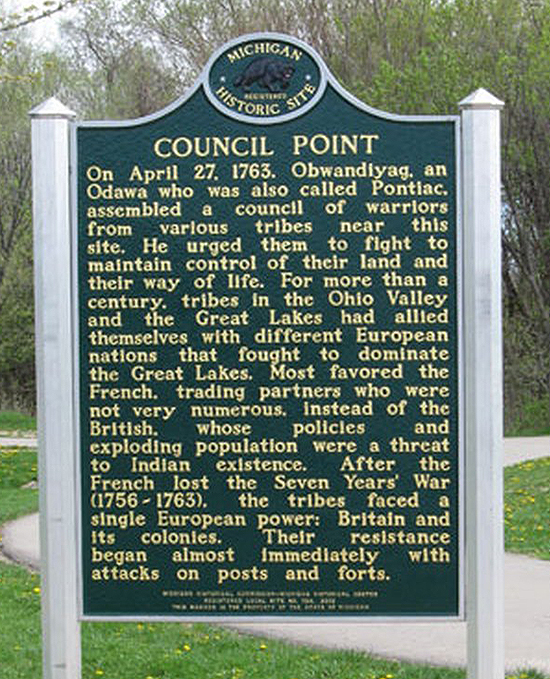
Council Point Marker
Lincoln
Park Historical Society
Why the name Ecorse? Because the
French called it Rivière aux Écorses or
Tree-Bark River) The Ecorse River flows
from the northwest into the Detroit River near
the northern tip of Turkey Island (today's
Fighting Island, Canada).

Map Location of Fort Detroit and the Ecorse
River
Histoire générale
des Voyages (Paris, 1746-1759; 15 volumes)
by Prévost / Bellin
Click to enlarge
Pontiac speaks to an audience of about 500 people, among them chiefs and warriors of the Ottawa,
the Potawatomi, and the Wyandot (or Huron)
Nations. Some French people are probably
assembled as
well, considering that there are approx. 2,000
French people living at Detroit by now.
News of what
exactly the terms of the 1763 Treaty of Paris
are, have not arrived yet. Pontiac still
believes the French are major players and that
they will
come to his aid.
Pontiac first
recites a list of grievances against the
British. He then displays a red and purple
wampum belt, a war belt, that he
claims he has received from their French Father,
the King of France, in order to unite and fight
against the British. And, finally, Pontiac quotes the
 Delaware
Prophet, who made if perfectly
clear that the white man should be driven out. Delaware
Prophet, who made if perfectly
clear that the white man should be driven out.
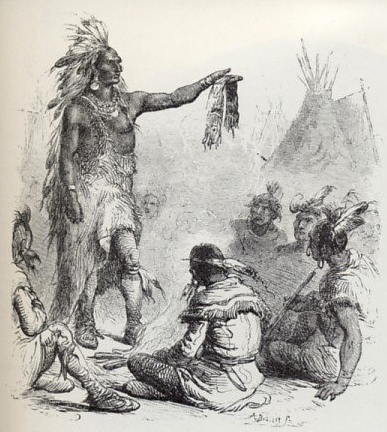
Pontiac Presents a War Belt at the Tribal
Council
Historical
Narratives of Early Canada
Pontiac's speech hits the target. Everyone
in the attendance is ready to follow his
lead.
Pontiac's
Rebellion begins.
Pontiac sends war
belts across the land and soon, other tribes will join.
Naturally, the center and focus of Pontiac's
operations is Detroit, the strongest British
post west of Niagara.
May 1, 1763
Pontiac and 40 warriors appear at the main gate
of Fort Detroit. They ask permission to enter so
that they could demonstrate their loyalty to the
British by dancing the calumet, or peace
dance, a variation of smoking the calumet,
or peace pipe. In actual fact, this is a
reconnaissance mission. While some of the
warriors are performing the dance, others keenly evaluate the strength and vulnerability
of the fort.
Pontiac's first
planned strike is to meet with the commander of Fort Detroit,
Major Henry Gladwin, on May 7, 1763. Pretending
to come in peace, Pontiac and his men would then, on
his signal, suddenly attack the 130 British
soldiers and officers garrisoned at the fort.
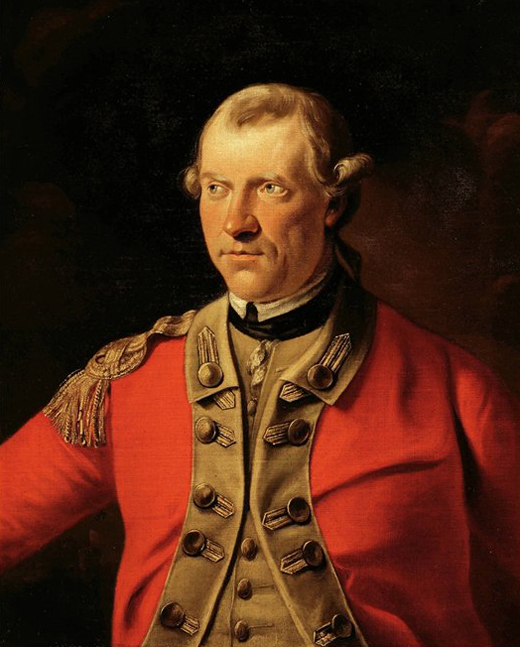
Half Length Portrait of Major
Henry Gladwin
(1730-1791)
Gladwin (city and county) in Michigan is named
after him, by the way.
Oil on
canvas by John Hall (1739-1797)
Detroit
Institute of Arts
May 6, 1763
An
informant, or informants, leak to Gladwin that the meeting with Pontiac
tomorrow is actually a
ploy to massacre the
entire garrison.
May 7, 1763
Pontiac, his fellow chiefs, and around 300
warriors meet with
Gladwin, who, in turn, has arranged a massive display of
all the firepower at his disposal, ready on his
command. Pontiac realizes that the entire fort
is on high alert, and that his plan has been
uncovered. He decides not to give the signal for the
attack.
Also on
May 7,
1763
Capt.
Charles Robertson and
Sir Robert Davers,
a British adventurer, are leading a soundings expedition in the
upper St. Clair River near today's Port Huron,
when they are attacked by a group of the Saginaw
Chippewa who are en route to join Pontiac at
Detroit. Robertson and Davers are killed along
almost all of their soldiers.
One of the
survivors, seventeen-year-old
John Rutherford, is taken captive and
will be adopted by
a Chippewa family. The Saginaw Chippewa Chief Perwash
will become John's adopted father. John will
go on to serve in the Black Watch, and to live
to age 84. Here you can read
 John Rutherfurd's
Narrative of a Captivity, which
was published in the April 1958 issue of
American Heritage.
John Rutherfurd's
Narrative of a Captivity, which
was published in the April 1958 issue of
American Heritage.
May 8, 1763
Pontiac and three Ottawa chiefs go back to
Gladwin, claim there must have been a
misunderstanding, and promise to be back
shortly to smoke the pipe of peace.
May 9, 1763
Pontiac and his men return to Fort Detroit with
65 canoes. This time, Gladwin does not open the
gates. Pontiac begins the six-month
Siege of Fort Detroit. This is also called
Pontiac's Siege. Although vastly outnumbered, Gladwin and his men will be
able to hold the fort.
The unprotected
settlements around the fort, however, are quickly
ravished, stores broken into and live stock
taken. Nine British settlers and one French
settler, Francois Goslin, who was mistaken for
an Englishman, are killed. The rest is captured.
May 10, 1763
Pontiac
claims he is ready for peace negotiations and
meets with Capt. Donald Campbell,
Lieut.
George McDougall, and a few other
British soldiers at the home of
Antoine Cullerier. Pontiac
decides to hold the men hostages. Concluding to
have thus gained an upper hand in negotiations,
Pontiac sends a
French messenger to Gladwin at Fort Detroit,
demanding the same terms the British demanded
from the French, complete surrender. But Gladwin
doesn't flinch. Campbell, MacDougall, and the
others will attempt to escape
on
 July
2, 1763. July
2, 1763.
Now that Fort
Detroit is cut off, the Indians who live around
the British forts, rise up.
Gladwin writes to
Jeffrey Amherst for reinforcements:
The
enemy are still masters of the country and
are likely to be so, if your Excellency does
not send a body of men to disperse them.
Amherst sends support via schooners on the
Detroit River, that are too large to be attacked
from Indian canoes. Small parties even get out
of the fort and are able to destroy buildings
the besiegers are using for cover. Amherst hands
out a new policy, Take no Indian prisoners.
May 13, 1763
A
unit of British soldiers and rangers, 96 men in
all, led by Lieutenant Abraham Cuyler, leave Fort Niagara
for Fort
Detroit, unaware of the hostilities. On
 May 28, 1763,
many of them will be killed.
May 28, 1763,
many of them will be killed.
May 16, 1763
Fort Sandusky (Ohio) falls after an attack by
Ottawa and Wyandot (Huron) warriors. The entire
15 man garrison is killed, its commander
Christopher Pauli is taken prisoner
and brought to Detroit.
May 18, 1763
Pontiac calls a meeting with all habitants of
Detroit and demands that they write a letter to
 Neyon de Villiers, French commander of Fort de
Chartres, to ask for help. The villagers did so,
apparently under duress, as they attached a note to
their letter to Villiers,
Neyon de Villiers, French commander of Fort de
Chartres, to ask for help. The villagers did so,
apparently under duress, as they attached a note to
their letter to Villiers,
We are forced to
submit to what the Indians demand of us. The
English are shut up, and all passages are cut
off. We cannot express our perplexity to you
[...]
May 25, 1763
Fort St. Joseph, today's Niles, Michigan, is
attacked by Potawatomi warriors, led by
Chief Washee. The fort falls,
12 of its 15 man garrison are killed. Commander
Francis Schlosser
and the rest are taken prisoner and brought to
Detroit.
May 27, 1763
Fort Miami (Fort Wayne, Indiana) falls after an
attack by the Miami tribe.
Commander Robert Holmes
and three of his men are killed, the rest of his 15 man
garrison surrenders.
May 28, 1763
The
Siege of Fort Pitt
(formerly Fort Duquesne, today's Pittsburgh) begins, led by Delaware and
Mingo warriors. Captain
Simeon Ecuyer is the
commander of the fort. During this siege, smallpox
infested blankets are given to the Indians.
Whether or not this early attempt at germ
warfare was successful and who exactly deserves
credit and blame remains a controversy.
What we do know is
that
Amherst lost his initial trivializing approach
to alleged Indian schemes ("Meer Bugbears"
Amherst to Sir William Johnson, April 3, 1763)
and wrote that the British would
Do well
to try to inoculate the Indians, by means of
blankets, as well as to try every other
method, that can serve to extirpate this
execrable race.
He asks Bouquet,
Could
it not be contrived to send the smallpox
among those disaffected tribes of Indians?
We must, on this occasion, use every
stratagem in our power to reduce them.
Memorandum by
Sir Jeffrey Amherst, May 4, 1763
Also
May 28, 1763
Lieutenant Abraham Cuyler and his men, who left Fort Niagra on
 May
13, 1763, for Detroit, stop at Point Pelee
(Ontario) to camp for the night. They are
planning on crossing Lake Erie tomorrow where
they wish to deliver 139 barrels of provisions and
reinforcements at Fort Detroit. However, they are
ambushed by the Wyandot, more than half of them
are killed, and 8 of their 10 boats are taken.
The survivors escape in their remaining two
boats first to Fort Sandusky. After seeing that
the fort there has been captured as well, they
return to Fort Niagara. May
13, 1763, for Detroit, stop at Point Pelee
(Ontario) to camp for the night. They are
planning on crossing Lake Erie tomorrow where
they wish to deliver 139 barrels of provisions and
reinforcements at Fort Detroit. However, they are
ambushed by the Wyandot, more than half of them
are killed, and 8 of their 10 boats are taken.
The survivors escape in their remaining two
boats first to Fort Sandusky. After seeing that
the fort there has been captured as well, they
return to Fort Niagara.
Also
May 28, 1763
A British settlement 10 miles southeast of
Fort Pitt (today's West Newton, PA) is attacked
by the Delaware and Mingoes, led by Delaware
Chief Wolfe.
May 31, 1763
Chief
Wasson and his Chippewa (or Ojibwa) warriors
from the Saginaw River arrive at Detroit. Wasson
and Pontiac resolve, instead of tightening the
siege of Fort Detroit, to focus on preventing
British relief forces from reaching the fort.
French citizens of Detroit are now supplying the
fort with provisions.
June 1, 1763
Fort Ouitenon (5 miles southwest of today's Lafayette, Indiana) falls
without a shot. The
attacking Weas, Kickapoos, and Mascoutens simply
walk in and take
the 20 man garrison prisoner. Commander
Lieutenant Edward Jenkins wisely choses to
surrender. He and his men will be exchanged for
enemy prisoners.
June 2, 1763
- Fort Michilimackinac (Northern Michigan) is
attacked by Chippewa (Ojibwa) and Sauks warriors. The
fort falls, 21 of the 35 man garrison are
killed. The fort's commander,
Captain George Etherington, and his deputy,
Lieutenant William Leslye are taken prisoner. Among the killed is
Lieutenant John Jamet, who had come with a small
unit from St. Mary's (today's Sault Ste. Marie).
This attack was a sneaky one. News from
the outbreak of Pontiac's Rebellion hasn't yet
arrived at this fort. The Chippewa who live in
the neighborhood, however, were well-informed.
They gather just outside the fort, and start
playing a game of baggatiway, or lacrosse.
Suddenly the ball is thrown over the wall, the
players are chasing after it while passing their
women and taking weapons from underneath their
blankets. The entire attack is over within
minutes.
Also on
June 2, 1763
Fort
Ligonier (Pennsylvania) is attacked by Delaware,
Shawnee, and Mingo warriors. This attack is
unsuccessful. No casualties.
June 4, 1763
Ottawa
warriors, led by Chief Okinochumake, take
the Fort Michilimackinac prisoners from the
Chippewa. The prisoners will later be brought to
Montreal for prisoner exchange.
June 8, 1763
Chief Sekahos and his Chippewa (or Ojibwa)
warriors from the Thames River arrive at
Detroit.
By now, Pontiac
leads more than 850 warriors: approx. 250 Ottawa, 150
Potawatomi, 50 Huron (or Wyandotte), 250 Saginaw
Chippewa (or Ojibwa), and 170 Thames River
Chippewa (or Ojibwa).
June 16, 1763
Fort Venango (or Fort Machault, today's
Franklin, Pa) falls. The attacking Seneca
warriors kill the entire 15 man garrison,
including its commander
Lieutenant Francis
Gordon, and burn the fort to the ground.
June 18, 1763
Fort Le Boeuf (today's Waterford, Pa) falls
after an attack by Seneca warriors. Two men are
killed, the fort destroyed. The survivors, including its commander
George Price, escape to Fort Venango. Seeing
that Fort Venango has been taken as well, they
move on to Fort
Pitt.
Also on
June 18,
1763
Father Dujonois, the Jesuit missionary
among the northern Ottawa,
Chief Kinonchamek (who is
the son of the great Chippewa
Chief Minavavana),
seven Ottawa, and eight Chippewa warriors arrive
at Detroit. They bring Pontiac the good news of
the capture of Fort Michilimackinac, see
 June
2, 1763. June
2, 1763.
June 19, 1763
The
Siege of Fort Presque Isle (today's Erie,
Pa) begins. A massive crowd of over 250 Ottawa,
Chippewa (or Ojibwa), Wyandot (or Huron), and Seneca warriors will
stick around until June 22.
June 21, 1763
At
Fort Edward Augustus (or Fort LeBaye, today's
Green Bay, Wisconsin) the fort's commander,
Lieutenant James Gorrell receives a message from
Captain Etherington, telling him to abandon the
isolated fort and to get to L'Arbe Croche (Cross
Village).
Gorrell and his men leave with the quickness.
June 22, 1763
The
Siege of Fort Presque Isle ends when the 60
man garrison surrenders. Three men are killed,
the rest, including the fort's commander
John
Christie, are taken prisoner and brought to
Detroit. The fort is destroyed.
July 2, 1763
Campbell and MacDougall, still Pontiac's
hostages, resolve to escape. McDougall and a few
other British prisoners make it into the forest,
but Captain Donald Campbell, slowed down by some
extra pounds and his very bad eye-sight, prefers to stay
put.
July 4, 1763
Captain Donald Campbell is tomahawked by Saginaw
Chippewa Chief Wasson to avenge the killing of
his nephew by British soldiers. The British are
outraged. In effect, Pontiac's men had killed a
British envoy sent to negotiate peace. Amherst
is fuming, and puts a 100-pounds reward on
Pontiac's head.
Fort Detroit has
now a French militia. This is the first time
since the surrender of New France in 1760, that
the French at
Detroit are officially carrying arms again.
James
Sterling, born in Ireland and now a
prominent trader at Fort Detroit, is made
captain of the French militia. Go here for more
about the
 James Sterling Letter Book.
James Sterling Letter Book.
July 6, 1763
The
Ottawa try to set fire to the British ships that
are moored at Fort Detroit by settings rafts on fire
and sending them downstream. This attempt is
consistently unsuccessful and will soon be
abandoned.
Here is an excerpt from a letter
written at Fort Detroit on this day:
We have
been besieged here two months by six hundred
Indians. We have been upon the watch night
and day, from the commanding officer to the
lowest soldier, since the 8th of May. We
have not had our clothes off, nor slept a
night since the siege began. We shall
continue so till we have a reinforcement.
Then we hope to give a good account of the
savages. Their camp lies about a mile and a
half from the fort. That is the nearest they
choose to come now.
For the
first two or three days we were attacked by
three or four hundred of them. But we gave
them so warm a reception that they do not
care for coming to see us, though they now
and then get behind a barn or a house and
fire at us at three or four hundred yards
distance. Day before yesterday we killed a
chief and three others, and wounded some
more. Yesterday we went up and our sloop and
battered their cabins in such a matter that
they are glad to keep farther off.
Mid-July 1763
A
prisoner exchange brokered between Wyandot
(Huron) and Potawatomi and Major Henry Gladwin
goes awry when the natives try to withhold
some of their British prisoners.
July 14, 1763
Jacques Cavallier, age 30, is killed
by a Potawatomi sniper while standing sentinel at Fort Detroit. Cavallier was a
member of the French milita at the fort. He is
one of only two Frenchmen who will be killed
during the Siege of Fort Detroit.
July 29, 1763
This morning, a
relief force of 260 troops from the 55th and the
80th Regiments, led
by Captain John Dalyell (aka General Amherst's
right hand), and 20 independent rangers, led by
Major Robert Rogers,
arrives at Detroit with provisions and
ammunition. Dalyell is eager to engage
in combat. Gladwin will later remember:
On the
31st, Captain Dallyell requested, as a
particular favor, that I would give him the
command of a party in order to attempt the
surprizal of Pontiac's camp under cover of
the night. To which I answered, that I was
of the opinion, that Pontiac was too much on
his guard to effect it. He then said he
thought I had it in my power to give him a
stroke, and that if I did not attempt it
now, he would run off, and I should never
have another opportunity. This induced me to
give in to the scheme, contrary to my
judgment.
Major Gladwyn
to Sir Jeffrey Amherst, Detroit, August 8,
1763
July 31, 1763
Battle of Bloody Run
- a six-hour engagement and one of the largest victories for Pontiac.
At 2:30 AM,
Dalyell and 247 troops put boots on the road and
march from Fort Detroit to
surprise Pontiac's camp. When they get close to
the bridge at Parent's Creek / Jean Baptiste
Meloche's farm, they are ambushed from three
sides by Pontiac's men, a combined force of
Ottawa, Chippewa, and Wyandot.
Frenchman
Meloche, by the way, is a friend of Pontiac. And
yes, Pontiac's French
friends had informed him of this planned
surprise attack.
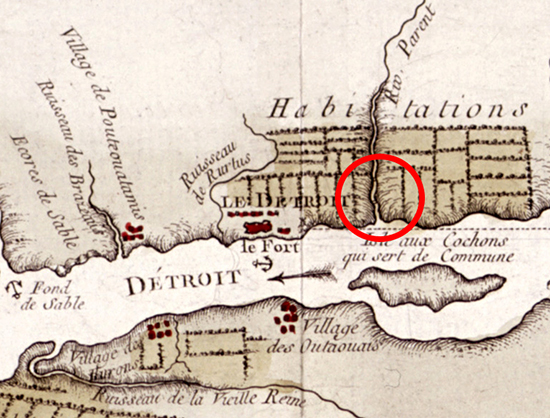
Map Location Battleground Bloody Run
The Battle
of Bloody Run was fought at Parent's Creek
(French: Riviere Parent), later it became
Bloody Run
Click map
to enlarge
The British suffer
150 casualties, including Dalyell. Some are
taken prisoner, the rest retreats with the
wounded to the fort.
Lincoln Park Historical Society tells us,
A
remnant of the creek is found in Elmwood
Cemetery today; an historical marker
commemorating the ‘Battle of Bloody Run’ is
located at the entrance to the Players Club
building at 3321 East Jefferson Avenue near
Mt. Elliott.
Pontiac's great
victory at Bloody Run had two effects. More
Indians were joining his cause and more resolve
toughened the British.
August 1, 1763
Large groups of Delaware and
Shawnee warriors leave the Siege of Fort Pitt
to intercept an approaching
British force led by Colonel Henry Bouquet. This
they will, in the Battle of Busy Run, on August
5, 1763.
August 2, 1763
Bouquet’s troops, about 500 men, 300 of them
members of the 42nd Royal Highland Regiment, The
Black Watch, reach Fort Ligonier. They rest for
two days, and transfer the flour provisions for
Fort Pitt from the wagon barrels they had been
using to 340 packhorses.
August 5, 1763
The
Battle of Bushy Run begins. The British, led by Col.
Henry Bouquet (1719-1765) arrive from Carlisle
to relieve Fort Pitt. Thirty miles southeast of
Fort Pitt, a well-camouflaged group of Delaware,
Shawnee, Mingo, and Wyandot warriors launch a
frontal attack on Bouquet's advanced guard. The
first day of fighting was won by the Indians.
August 6, 1763
The
Battle of Bushy Run ends. Colonel Henry Bouquet (an expert of
warfare against irregular opponents) defeats
the Indians thanks to a surprise strategy. Two
British companies pretended to withdraw, luring
Pontiac's men out of their cover and into a lethal
crossfire. This is the first time that the
British have fought the enemy on its own terms
and won. End of battle. British Casualties: 50
killed, 60 wounded.
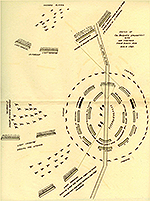
Sketch of the Battle of Bushy Run
Click to enlarge
This is the
beginning of the end of Pontiac's War. His
rebellion will lose momentum in part because of
today's defeat, in part because of the stalemate
at Detroit, and in part because the
Indians will soon have to move with the changing
season and retreat to their winter hunting
grounds.
August 10, 1763
Bouquet and his men reach Fort Pitt.
The Siege of Fort Pitt
ends.
September 1763
A copy of the 1763 Paris peace
treaty reaches Fort de Chartres on the
Mississippi River, Illinois Country. After
contemplation, its French commander,
Major
Pierre Joseph Neyon de Villiers, decides to encourage the Indians to become peaceful with
the British, and writes a letter addressed to
all Indians:
My Dear
Children... The great day has come ... the
Master of Life has inspired the Great King
of the French and him of the English to make
peace between them, sorry to see the blood
of men spilt so long. ... What joy you will
have in seeing the French and English
smoking with the same pipe and eating out of
the same spoon and finally living like
brethren. ... Leave off then, my Dear
Children, from spilling the blood of your
brethren, the English. Our hearts are now
but one. You cannot at present strike the
one without having the other for your enemy
also.
By the way, what's a Frenchman doing still commanding
a fort?
Neyon de Villiers was the French commander of
Illinois. Now his turf was officially under
British rule, but with no British troops in
sight. The Fort de Chartres will have a transfer
ceremony on October 10, 1765, when finally
British troops of the 42nd Royal Highland
Regiment will take over.
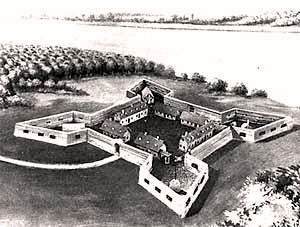
The French Stone Fort de Chartres
Illinois
Historic Preservation Agency
September 3 and 4, 1763
When the
schooner Huron, loaded with provisions from Fort
Niagara, is moored in the lower Detroit River
near Turkey Island (today's fighting Island),
approx. 340 Ottawa and Chippewa warriors attack.
Two British aboard are killed. The ship's
captain, Captain Horsey, is one of them.
September 9, 1763
Amherst to Henry Gladwin:
By a
formal letter I had offered a reward of 100
pounds to the person who should kill
Pontiac. If you think another 100 could be
inducement for a daring fellow to attempt
the death of that villain, I will add it
with pleasure. His death will be some small
satisfaction for the loss of poor Dalyell.
September 14, 1763
Battle of Devil's Hole
(near Fort Niagara, NY). Seneca warriors attack
a lightly escorted British wagon train that
rolls north along the Niagara Gorge, between Fort Schlosser and Fort
Niagara. The wagons were returning to the Lower
Landing (Lewiston) for another load of
provisions. Just when the convoy approaches the
creek flowing into Devil's Hole, they rumble
across a small wooden span, later known as
Bloody Bridge. Here the Seneca attack. Well aware of the importance of the
British supply lines, they destroy the draft
animals and throw harness and wagons into the
gorge.
Alarmed by the
gunfire, British troops of the 80th Regiment of
Foot, who are encamped at the Lower Landing two
miles down the river, rush to the convoy's aid,
but are ambushed as well. The troops are led by
Lieutenant George Campbell. They were on their
way to Detroit. In this second ambush, the
Seneca kill 80 British troops, slightly north
of Devil's Hole in what will become known as
Campbell's Defeat. Only 8 wounded men
make it back to Fort Niagara.
This is bloodiest battle of the Pontiac War,
hence also called the Devil's Hole Massacre. It will be weeks
before the British will again be able to supply
Detroit with its necessary provisions.
This is the
closest Fort Niagara comes to being attacked.
The fort itself was never actually threatened.
October 7, 1763
Royal Proclamation by British King George III,
aka the
 Proclamation
of 1763. Proclamation
of 1763.
The Proclamation
of 1763, is a remarkable decree. For example, it
acknowledges that "great Frauds and Abuses have
been committed in purchasing Lands of the
Indians."
Here is an
excerpt:
And We do further
declare it to be Our Royal Will and Pleasure,
for the present as aforesaid, to reserve under
our Sovereignty, Protection, and Dominion, for
the use of the said Indians, all the Lands and
Territories not included within the Limits of
Our said Three new Governments, or within the
Limits of the Territory granted to the Hudson's
Bay Company, as also all the Lands and
Territories lying to the Westward of the Sources
of the Rivers which fall into the Sea from the
West and North West as aforesaid.
In other words, from now on, the
territory between the Appalachian Mountains and
the Mississippi River and from the Great Lakes
more or less down to the Gulf of Mexico, is reserved exclusively
for the Indians. The British colonies in North
America have a firm western boundary. Those whites who have already
settled beyond this border line are ordered to remove themselves.
Although this act will be ignored by future
settlers and law makers, this is the first time
in North American colonial history that Indian
property rights are officially recognized.
Here is the map

1763 North America
after the Treaty of Paris (February
10, 1763)
and after the Royal
Proclamation (October 7, 1763)
October 29, 1763
Pontiac is shown Neyon de
Villier's letter to all Indians in former New France.
He realizes that his former French allies have
cut their ties.
However, he will
not give up and will arrange a meeting with
Neyon on
 April 15, 1764. April 15, 1764.
October 31, 1763
Pontiac lifts the
Siege of
Fort Detroit and withdraws to the Maumee River.
He sues for peace, and writes to Gladwin:
My
Brother, the word that my father has sent to
make peace I accept; all of my young men
have buried their hatchets.
I think
that yon will forget the bad things that
have happened this past while. For my
part I shall forget, which you can show me
how to do, in order to think only of good
things.
I, the
Ojibwas, the Hurons, we must go to speak to
you when you will ask us. Reply to us. I am
sending you the adviser so that you may see
him. If you are indeed like me you will give
me a reply.
I send
you greetings.
Gladwin replies that he would forward
Pontiac's message to the general.
December 1763
Conestoga Massacre, also called the
Paxton Boys Uprising, near Lancaster, PA.
Fifty-seven drunken frontiersmen from Paxton slaughter 20 peaceful
and defenseless Conestoga Indians, and will get away with it.
April 15, 1764
Neyon receives Pontiac, who asks for his support
against the British. Neyon declines, referring to the peace treaty
between Britain and France.
August 27, 1764
Colonel John Bradstreet arrives
from Niagara with his expedition that was sent to lift the siege of
Detroit. Bradstreet encounters no opposition.
Bradstreet also has instructions to
punish the natives, but he prefers to make treaties with hostile
tribes. This will not sit well with his superior, Major-General
Thomas Gage.
Also on
August 27, 1764
Shawnee
chief Charlot Kaske seeks in vain the military support of
Louis Groston de Saint-Ange de Bellerive, commander at Vincennes.
Late October 1764
Bradstreet and his
men attempt to return across Lake Erie. Storms cost the lives of
many of his men.
December 1764
The Shawnee appeal to
the French authorities in New Orleans to help them out in their
fight against the British.
February 1765
Once again, the
Shawnee ask the French at New Orleans for help, still without success.
April 18, 1765
Peace talks between Pontiac and
Louis Groston de Saint-Ange de Bellerive and
Lieutenant
Alexander Fraser.
July 1765
At Fort Ouiatenon, now in
native hands, Colonel George Croghan,
Johnson's chief deputy supervisor of Natives affairs for the English
colonies of America, and Pontiac
come to an agreement to end the uprising. A preliminary settlement is signed. Pontiac
points out that the French submission to the British has
nothing to do with the Indian Nations, as the French had not
conquered them. Thus, the British should not assume the submission
of the natives.
August 17, 1765
Croghan and Pontiac are
meeting with chiefs of the Ottawa, Ojibwa, Huron, and Potawatomi to
ratify this agreement. Not everyone, however, is convinced.
July 25, 1766
The Algonkian chiefs and Pontiac meet at Fort
Ontario (Oswego, NY) to sign a final peace treaty.
Sir William Johnson,
British Superintendent of Indian Affairs, presides. He lets Pontiac
speak for all of them, which further alienates them.
Pontiac's
Rebellion ends.
Among some Indians, Pontiac has by now acquired a reputation of
having sold out his people to the British. A rumor that he is on
British payroll doesn't help.
Pontiac sticks to the treaty with the
British. His village exiles him.
Skirmishes between Indians and whites continue here and there
but Pontiac stays true to his word. He is done fighting and resumes
his life as an independent fur trader.
March 30, 1769
Pontiac arrives at
Cahokia, Illinois.
April 20, 1769
At Cahokia, Pontiac
enters the store of Baynton, Wharton, and Morgan, accepts a drink, leaves the store,
and is attacked and killed by a Peoria Indian.
It is debated whether the killing was
motivated by individual disgruntlement, tribal disgruntlement, or
whether it was a paid assassination.
John Wilkins, commander of Fort
Cavendish (formerly Fort de Chartres) immediately orders a local
businessman to bury the victim. No one knows where Pontiac is
buried.
Later, Ojibwa
Chief Minweweh will take revenge
and kill two employees of Baynton, Wharton, and Morgan, for a lack
of a better target.
More History
|